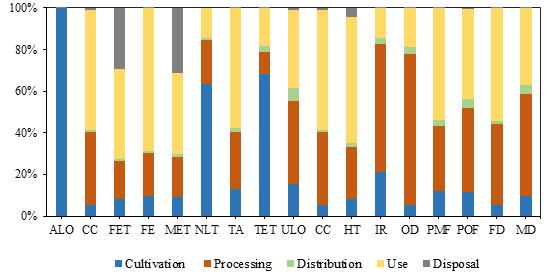Life Cycle Assessment of Ground Coffee and Comparison of Different Brewing Methods: A Case Study of Organic Arabica Coffee in Northern Thailand DOI: 10.32526/ennrj.17.2.2019.16
Main Article Content
Abstract
Billions of cups of coffee are consumed worldwide every year with little regard for the wide range of environmental impacts arising at different stages of its life cycle. This study aimed to assess the environmental impacts of a single cup of hot, black coffee brewed from ground organic Arabica beans produced and consumed locally in the northern region of Thailand. Environmental impacts throughout its life cycle were assessed and the influences of different brewing methods were compared. Life cycle assessment (LCA) was implemented to evaluate the environmental performance of the product system. The results found that coffee cultivation is a major contributor to ecosystem damage in all brewing scenarios, particularly on land-use related midpoint indicators. Preparing the coffee by moka pot is especially energy intensive and showed a high impact score on human health. It also demonstrated resource damage categories in the brewing stage that were directly related to fossil-based electricity consumption. For other brewing scenarios, the upstream processes such as cultivation and bean processing were major contributors to environmental harm. According to the farming scenario analysis, the application of chemical fertilizers during conventional farming can aggravate the impact from the cultivation process on human health and resources, as compared to organic farming. This study comprises an initial stage of a coffee LCA study in Thailand. Hopefully, it can add to the body of information pertaining to the life cycle environmental impacts of coffee, a popular beverage product, aid decision-making, and increase attention on the importance of sustainable products.
Article Details
Published articles are under the copyright of the Environment and Natural Resources Journal effective when the article is accepted for publication thus granting Environment and Natural Resources Journal all rights for the work so that both parties may be protected from the consequences of unauthorized use. Partially or totally publication of an article elsewhere is possible only after the consent from the editors.
References
2. Ambinacudige S, Choi J. Global coffee market influence on land-use and land-cover change in the Western Ghats of India. Land Degradation and Development 2009;20:327-35.
3. Beyene A, Kassahun Y, Addis T, Assesfa F, Amsalu A, Legesse W, Kloos H, Triest L. The impact of traditional coffee processing on river water quality in Ethiopia and the urgency of adopting sound environmental practices. Environmental Monitoring and Assessment 2012;184:7053-63.
4. Büsser S, Jungbluth N. The role of flexible packaging in the life cycle of coffee and butter. International Journal of Life Cycle Assessment 2009;14:80-91.
5. Chayer JA, Kicak K. The Final Report of Study Project: Life Cycle Assessment of Coffee Consumption: Comparison of Single-serve Coffee and Bulk Coffee Brewing. Montreal, Canada: Quantis; 2015.
6. Coltro L, Mourad AL, Oliveira PAPLV, Baddini JPOA, Kletecke RM. Environmental profile of Brazilian green coffee. International Journal of Life Cycle Assessment 2006;11(1):16-21.
7. Department of Agricultural Extension (DOAE). Annual Coffee Production Report 2016. Bangkok: Department of Agricultural Extension (of Thailand); 2016.
8. Department of Alternative Energy Development and Efficiency (DEDE). Energy Balance of Thailand [Internet]. 2016 [cited 16 Jan 2017]. Available from: https://www.dede.go.th/download/state_59/Energybalance2016.pdf.
9. Department of Land Transport (DLT). Transport Statistics Report in 2016. Bangkok: Department of Land Transport (of Thailand); 2016.
10. Goncalves M, Guerreiro MC, Ramos PH, de Oliveira LCA, Sapag K. Activated carbon prepared from coffee pulp: potential adsorbent of organic contaminants in aqueous solution. Water Science and Technology 2013;68(5):1085-90.
11. Goedkoop M, Heijungs R, Huijbregts M, Schryver AD, Struijs J, van Zelm R. ReCiPe 2008: A Life Cycle Impact Assessment Method which Comprises Harmonized Category Indicators at the Mid-point and the Endpoint Level. 1st ed. Netherlands: National Institute for Public Health and the Environment; 2013.
12. Hassard HA, Couch MH, Techa-erawan T, McLellan BC. Product carbon footprint and energy analysis of alternative coffee products in Japan. Journal of Cleaner Production 2014;73:310-21.
13. Hick AL. Environmental implications of consumer convenience coffee as a case study. Journal of Industrial Ecology 2017;22(1):79-91.
14. Humbert S, Loerincik Y, Rossi V, Margni M, Jolliet O. Life cycle assessment of spray dried soluble coffee and comparison with alternatives (drip filter and capsule espresso). Journal of Cleaner Production 2009;17:1351-8.
15. International Coffee Organization (ICO). The Current State of the Global Coffee Trade [Internet]. 2016a [cited June 11, 2018]. Available from: https://www.ico.org/monthly_coffee_trade_stats.asp.
16. International Coffee Organization (ICO). Annual Review 2015-2016. London, United Kingdom: International Coffee Organisation; 2016b.
17. Jokanovic MR, Dzinic NR, Cvetkovic BR, Grujic S, Odzakovic B. Changes of physical properties of coffee beans during roasting. Acta Periodica Technologica 2012;43:21-31.
18. Methawarakul T, Manochai B, Chulaka, P, Pichakum N, Changlek P. Effect of pruning and fertilizer applications on productivity and quality of Arabica coffee beans at Phetchabun research station. Agricultural Science Journal 2017;48(2):284-96.
19. Noponen MRA, Edwards-Jones G, Haggar JP, Soto G, Attarzadeh N, Healey JR. Greenhouse gas emissions in coffee grown with differing input levels under conventional and organic management. Agriculture, Ecosystems and Environment 2012;151:6-15.
20. Salomone R. Life cycle assessment applied to coffee production: investigating environmental impacts to aid decision making for improvement at company level. Food, Agriculture and Environment 2003;2:295-300.
21. Tchibo. Case Study Tchibo Privat Kaffee Rarity Machare. PCF Pilot Project. Berlin, Germany: Tchibo GmbH; 2009.

